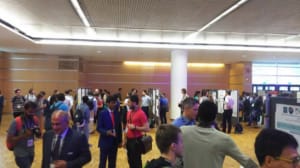CLEO/Europe-EQEC 2017 Ryo Suzuki
Research
International Conference Report 2017
CLEO®/Europe-EQEC 2017 Participation Report
Ph.D.2Year: Ryo Suzuki
Participating Conferences
CLEO®/Europe-EQEC 2017 (CLEO Europe 2017)
Dates: June 25 - 29, 2017
Location: ICM Centre, Munich, Germany
2. About CLEO Europe 2017
CLEO Europe is an optics-related conference held in Europe every two years and was held in Munich, Federal Republic of Germany. Beer was served at the conference venue around 6:00 p.m., and on one day, a conference dinner was held in a separate hall from the conference venue. The presentations related to Kerr comb, the research topic of the presenter, were similar to those at the CLEO held in the U.S. last month, and many of them had already been published or submitted to arXiv, so there was little new content. The exhibition of optics-related companies was held at the same venue, but it was very large, and I recommend taking a walk around it as a change of pace from the conference.
3. Presentation by the presenter
I gave a poster presentation on the relationship between optical carcombs and resonator optomechanics using silicatroid resonators. Although I was able to complete my presentation without any problems, I regretted that I should have made my poster more attractive by enlarging the size of letters and figures to make it easier for the audience to ask questions at a glance. In the poster presentation, I felt that it was important not only to introduce my own research but also to listen to and learn from those who asked questions about my research.
4. related announcements
CK-5.1 Whispering gallery micro-cavities (L. Yang)
He introduced the fundamentals and applications of the Whispering gallery micro optical resonators. Especially in the last part of the presentation, L. Yang's group was focusing on the application of micro optical resonators, such as temperature sensor using silicatroid resonators, application for iOS, and temperature mapping using drones, etc. L. Yang has a PhD from K. Vahala group, and I felt that his group was oriented toward application because he understood the high quality of basic research of competing groups. I felt that L. Yang's understanding of the high quality of the basic research of the competing group, which is why the group is taking a more application-oriented direction.
CK-6.4 Soliton Kerr Frequency Combs with Octave Bandwidth in Integrated Si3N4 Microresonators (M.H.P. Pfeiffer)
Kerr comb, which is generated from a micro optical resonator, is expected to be a new optical frequency comb light source, but it is necessary to control the repetition rate of the optical pulse and the carrier envelope offset frequency. The latter, in particular, requires coherent spectral generation over an octave in the frequency domain, whereas the Kerr comb has so far been limited to 2/3 octave. In this study, the dispersion of the resonator is controlled and dispersive waves are generated on both the low and high frequency side with respect to the pump frequency to achieve a coherent spectral spread of one octave. However, the repetition frequency is 1 THz, which is well beyond the bandwidth of photodetectors, and simultaneous control of the repetition frequency and carrier envelope offset frequency as mentioned above has not yet been realized.
EF-3.4 Temporal Dissipative Solitons in a Fabry-Pérot Microresonator Driven by Optical Pulses (T. Herr)
A Fabry-Pérot resonator with 10 GHz resonator mode spacing was fabricated by sandwiching an optical fiber ferrule between dielectric Bragg mirrors. 10 GHz-modulated light was used as input light, which seemed similar to the idea of an electro-optic modulation comb. Micro optical resonators can generate highly efficient nonlinear optical effects by confining light in a small volume, but this also makes it difficult to achieve stability. In this study, by using a different resonator and method from the conventional Soliton Kerr comb generation, the advantages of high stability and no need for fine control of the pump frequency were realized. The presenter, T. Herr, wrote a breakthrough paper on Soliton Kerr comb generation when he was a doctoral student, and we should pay close attention to the trend of this research, which was started by the presenter, who has a deep understanding of this issue, at his new organization.

- Categories
- 国際会議報告


